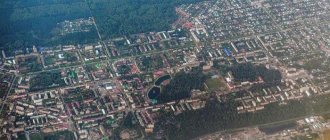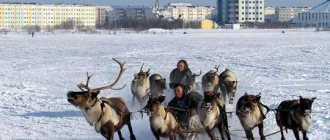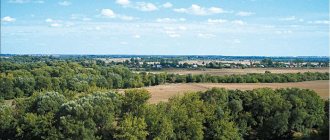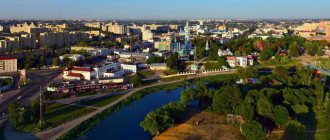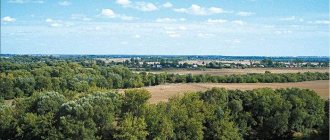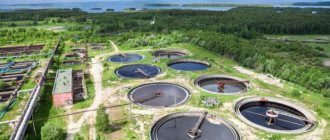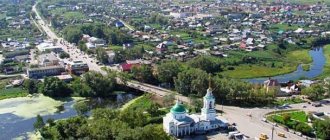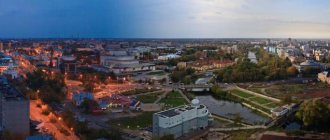- July 27, 2019
- Directions
- Molton
Kirov is a regional center in the northeast of the European part of Russia. Where is Kirov? The city is located 896 km northeast of Moscow, on the Vyatka River. It is the administrative center of the Kirov region. The number of inhabitants is 512,954 people. This is the industrial, scientific and cultural center of the Urals. A city with a long history. It dates back to 1181. It was the easternmost city of Ancient Rus'.
Kirov is divided into 4 districts. The height of the central part is 150 meters. The head of the city is Elena Vasilievna Kovaleva.
Geographical features
Many people are interested in the question: where is the city of Kirov? This regional center is located in the valley of the Vyatka River, in the middle part of its course, on the Russian Plain. Part of the Volga Federal District. Located in the taiga forest zone. Kirov is located in the Moscow time zone.
The climate is determined by where the city of Kirov is located. It's continental and cool. Characterized by frequent incursions of cold air masses from the Arctic Ocean located in relative proximity. Therefore, severe frosts are common in winter, and sudden cold snaps in summer. The city itself is noticeably warmer than the surrounding area. Annual precipitation is 677 mm. Most of them fall in the summer.
Within the city limits there are agricultural lands and specially protected natural areas.
Program of events in 2021
Figure 2. Festive concert
The city administration has officially approved the holiday program for residents and guests of Kirov. The celebrations will take place on Wednesday, June 12, in several public places.
Traditionally, the main concert program will take place on Teatralnaya Square and Oktyabrsky Prospekt.
Theatre square:
From 10:00 to 21:00 – city festival “Tasty Vyatka”. It will be represented by the city's most beloved and famous restaurants and cafes. Visitors will enjoy an extensive culinary program, master classes and secrets from the best chefs. 11:50 – ceremonial start of the “Team-645” motor rally. From 12 to 13:20 - congratulatory speeches from the leaders of the city and region, launching of balloons, singing of anthems. From 13:20 to 17:00 – performances by creative groups from the city of Kirov.
October prospect:
From 9 a.m. to 2 p.m. – sports marathon “Asphalt Ring”: training races, City Karting Cup, Duathlon Championship. From 18:00 to 21:00 there will be a concert of invited pop stars. 21:00 – festive fireworks.
Alexander Garden:
From 11 a.m. to 5 p.m., performances by creative groups from the city of Kirov, specially prepared for the holiday. From 11 to 20 o’clock – intellectual game “An Hour with Cappuccino” in the Chess House. From 12 to 15 o'clock there is a street theater festival for children.
From 17:00 to 22:00 – live performance by cover bands of the city with the “Retro FM” program.
The traditional holiday crafts fair will be held from 11 a.m. to 5 p.m. on the city’s main pedestrian street, Spasskaya. Festive events will also take place in all major parks of the city: Kirov Park, Kochurovsky Park, Gagarin Park and Apollo Park, as well as in the botanical garden.
Ecological problems
The main air pollutants in Kirov are industrial enterprises. The most common pollutants are carbon monoxide, dust and formaldehyde. The quality of water in the Vyatka River does not meet accepted standards. The main water pollutants are enterprises and household wastewater. The Institute of Microbiology of the Ministry of Defense of the Russian Federation has highly dangerous strains of viruses, which, in the event of an emergency, may be released.
Video review of Kirov sights
Kirov will certainly appeal to fans of city tours in Russia. And after watching the video we specially selected for you, you will be convinced that it is a rather interesting place.
In our article we cannot fully cover all the sights of the glorious city of Kirov. Here are only those that, in our opinion, deserve the greatest attention. If you have been to Kirov and want to talk about interesting places that were not described in our article, do so in the comments below.
Population of Kirov
The city's population grew rapidly during the Soviet era, stabilized in the 1990s, and then began to grow again. At the moment, moderate growth continues. In the list of cities of the Russian Federation, Kirov ranks 37th in terms of the number of inhabitants. Representatives of the female sex in Kirov are 56%. Among the residents, 96.6% are Russian. In second place are Tatars with a share of 0.79%, and in third place are Ukrainians (0.57%). The share of the working-age population is 63%. 237.9 thousand people officially work.
There is a large proportion of elderly people in Kirov. This is largely due to the fact that young people are actively leaving. Mostly they go to St. Petersburg or abroad. Residents of Kirov are distinguished by their friendliness.
KIROV
KIROV, city in Russia, adm. center of the Kirov region Us. 464.6 thousand people (2008). Located in the center. parts of the region, on the river Vyatka (stretches along the banks for more than 25 km). Large transport hub. River port. Airport.
Kirov. Holy Dormition Trifonov Monastery. 17th–18th centuries Photo by P. S. Pavlinov
Kirov. John the Baptist Church. 1714–23. Photo by P. S. Pavlinov
It was founded, according to the most common point of view in historiography, in 1374 by a detachment of Novgorod ushkuiniks passing through the Vyatka land after a campaign in the outskirts of the city of Bolgar (Bulgar). It was probably originally located on the steep left bank of the river. Vyatka, near the Zasora ravine, was called Vyatka. In 1391 it was devastated by the Horde detachment of Prince Bektut. In the end 14 – end 15th centuries center of Vyatka land. After construction at the mouth of the river. Khlynovitsa in the 2nd third – middle. 15th century Kremlin with an earthen rampart and trees. The name was assigned to the fortifications outside the city. Khlynov. Since 1489, the city, together with the Vyatka land, finally became part of Russia. state Being on the east. borders of the country, to the end. 16th century had a strategic meaning. From the beginning 17th century The Semyonovskaya fair operated, later manufacturing production arose, and the economy expanded. connections with cities of Rus. North, Urals, Urals, Volga region, Siberia. Since 1657, the center of the Vyatka and Veliko Perm (from 1799 - Vyatka and Slobodsk) dioceses. In the 2nd half. 17th century The Kremlin was rebuilt, the settlement is surrounded by an earthen rampart with trees. walls and towers (the shaft was partially preserved), stone construction began. In the 17th–18th centuries. in Khlynov chronicle writing began to develop (“Vyatka vremennik”, “Chronicle of Old Years”, “The Tale of the Vyatka Country”, etc.). District city of the Siberian province. (1708–27), Kazan province. (1727–80), center of the Vyatka province. (1719–1780). In 1780 it was again renamed Vyatka, the center of the Vyatka province (1780–1929; in 1780–96 Vyatka governorship). At 19 – beginning. 20th centuries place of politics exile, A. I. Herzen, A. L. Vitberg, F. F. Pavlenkov and others served their sentences here. Small-scale industries predominated in the city (leather tanneries, distilleries, bakeries and confectioneries, and other establishments). The lines of the Perm-Kotlas (1899) and Moscow-Yaroslavl-Arkhangelsk (1906) railways passed through Vyatka. In 1901 the Vyatka-Volga Shipping Company was created. On Nov. – Dec. 1917 owl was installed in the city. power. In 1929–34, the regional center of the Gorky (until 1932 – Nizhny Novgorod) region. Since the 1930s developed as an important industry. center. In 1934 it was renamed K. (in honor of S. M. Kirov). Center of the Kirov region (1934–36), from 1936 – Kirov region. During the period of Vel. Otech. war, K. is an important rear center; several were evacuated here. large enterprises, including Leningrad. the Krasny Instrumentalshchik plant (now the KRIN tool plant) and the Kolomna Locomotive Plant. plant (later production facilities were combined with railway workshops, now the Kirov Machinery Plant named after May 1).
Kirov. Pavilion (gazebo) of the Alexander Garden. 1835. Architect A. E. Timofeev. Photo by P. S. Pavlinov
Archaeological monuments have been preserved in Kazakhstan: the Nagovitsyn settlement (7th–3rd centuries BC), the Chizhevskoye settlement (8th–3rd centuries BC). The old part of the city, which received a rectangular grid of streets after the Highest approval of the regular plans of 1784 (architect I.M. Leim) and 1812 (architect V.I. Geste), is picturesquely located on the steep left bank of the river. Vyatka. South of former Kremlin, on the slope of the Zasora ravine, is the ensemble of the Holy Dormition Trifonov male monastery. (founded in 1580, closed in the 1920s, revived in 1991) with the 5-domed Assumption Cathedral (1684–89; late 17th century iconostasis, renewed in 1894–96; late 19th century paintings by Palekh masters ), the elegant Nikolskaya Gate Church. with features of the Naryshkin Baroque (c. 1700), the abbot's building and cells (18th century), the Annunciation Church. (1728, on the site of the first wooden church of the monastery) and c. Saints Athanasius and Cyril with a rich relief pattern of the walls (1717, in 1802 reconsecrated in the name of the Three Saints), wood. Chapel of St. Tryphon of Vyatka (restored in 1990 in the form of 1684). To the north, northwest and west of the former. Kremlin, on the territory of the former posad, - ensemble of the Spaso-Preobrazhensky Novodevichy women's monastery. (founded in 1624, closed in 1918, revived in 2001) with the elegant Spaso-Preobrazhenskaya Church. (1696), buildings of the 19th century; Ioanno-Predtechenskaya Church (Nativity of John the Baptist; 1714–23; octagonal in plan; twisted “horns” of window casings; the main nave was enlarged in 1898–99, architect I. A. Charushin), Znamenskaya Church. (until 1778 Tsarevo-Konstantinovskaya; 1697–99, rebuilt in the mid-18th century), Cathedral of the Savior Not Made by Hands (1760s, restored since 1999). Also preserved are the chambers of the Vyatka Spiritual Consistory (1752), the house of A.I. Perminov (1755); buildings in the style of classicism: 2 buildings of public places (1787–90, architect F. M. Roslyakov), the estate of S. Ya. Mashkovtsev (1792–1796, Roslyakov), Akhtyrskaya cemetery church. (1795), the Zhmakin estate (1815), the houses of the servants of the Spassky Cathedral (1826, architect I. D. Dussard de Neuville), buildings in the Alexander Garden (empire gazebos, 1835, architect A. E. Timofeev; entrance pavilion with cast iron fence, 1835–39, architect A. L. Vitberg); mansion of merchant Ya. A. Prozorov (1871–72, architect A. S. Andreev), other residential and administrative buildings. stone and wood Houses. According to the projects of the local architect. Charushin erected: ts. St. Seraphim of Sarov (now St. Seraphim Cathedral) in Russian style (1904–07), shopping arcades, P. P. Klobukov’s store in Art Nouveau style (1909), lush eclectic mansions (house of steamship owner T. F. Bulychev, 1911) . In the end 19 – beginning 20th centuries railways were also built. Kirov-Kotlassky station (1899), St. Petersburg. railway station (1906, reconstructed by 1961, in 1982), mosque (1909, architect M.V. Druzhinin). In Sov. The following buildings were built: the food industry club (1930, architect A. A. Dubrovsky), the House of Communications (1930, architect B. A. Korshunov), the Central Hotel (1937, Charushin), the House of Soviets (1949, architect E. I. Gromakovsky), hotel “Vyatka” (1967, architect B.V. Zyrin). On the right bank of the Vyatka, formerly With. Makarie, - Holy Trinity Women's Monastery. (1992) with the Trinity Church built by Ustyug craftsmen. (1770–75), c. St. Alexander Nevsky (1991); settlement Dymkovo (production of the Dymkovo toy). In the end 20 – beginning 21st centuries in K. built: wooden. c. New Martyrs and Confessors of Russia (1993), c. Faith, Hope, Love and their mother Sophia (2001–02, architect E. L. Skopin), c. St. Panteleimon (2003), Elias Church. (2003), wood. c. in honor of the Feodorovskaya Icon of the Mother of God (2007, architect Yu. V. Kuznetsov). In 1999, the Mikhailo-Arkhangelsk Ustyug Chapel on Razderikhinsky Spusk was restored in memory of the battle of the Vyatchans with the Ustyug people in 1418 (1875, destroyed in 1925).
Monuments: S. N. Khalturin (1923, sculptor N. I. Shilnikov, architect I. A. Charushin), bust of A. I. Herzen (1948, sculptor V. S. Ryazantsev, architect N. I. Kozlov) , S. M. Kirov (1957, sculptor N. V. Tomsky, architect Kozlov; 1966, sculptor G. E. Arapov, architects G. I. Gavrilov, E. I. Kutyrev), V. M. and A. M. Vasnetsov (1992, sculptor Yu. G. Orekhov, architect S. P. Khadzhibaronov), I. S. Konev (1994, sculptor A. Khaidetsky, architects V. I. Bortsov, V. I. Kropachev), etc. .
There are 7 research institutes in Kazakhstan, including 2 institutes of the Russian Academy of Agricultural Sciences - All-Russian. Research Institute of Hunting and Fur Farming named after. B. M. Zhitkova and Research Institute s. Farm of the North-East named after. N.V. Rudnitsky, as well as the Research Institute of Hematology and Blood Transfusion of the Ministry of Health of the Russian Federation. There are 24 state governments in Kazakhstan. and non-states. university (including branches of universities in Moscow, St. Petersburg, Perm, etc.), including Vyatka State. Humanitarian University (founded in 1914 as a teacher's institute, since 1995 pedagogical university, modern name since 2002), Vyatka state. agricultural Academy (founded in 1930 as the Vyatka Zootechnical and Veterinary Institute, current name and status since 1994), Vyatka State. University (founded in 1963 as the Kirov Correspondence Polytechnic Institute, since 1994 Vyatka Technical State University, modern name since 2001), Kirov State University. honey. Academy (founded in 1987 as a branch of the Perm State Medical Institute, since 1994 Kirov State Medical Institute, current name and status since 1999), Volga-Vyatka State Academy. services (1994). Regional libraries: Kirov State. universal scientific fuck them. A. I. Herzen (founded in 1837 as the Vyatka public library, in 1898–1917 named after Nicholas I), special. library for the blind (1956), children's room - named after. A. S. Green (1957), youth (1968); center. mountains fuck them. A. S. Pushkin (1900; about 20 branches).
Museums: Kirov Regional Local Lore. (founded in 1866 as a public museum; building 1813–16; including a collection of burl products), Kirov Regional Art Museum, K. E. Tsiolkovsky Museum, Aviation and Cosmonautics (1988), “Vyatka Peoples. artist crafts" (1977; in the rebuilt building of the former Prikaznaya hut, 1st half of the 18th century). Exposition and exhibition department “Vyatka Kunstkamera” (1992), museum and exhibition department (1977; architect A. P. Pavlov, artists A. I. Intezarov, N. N. Solomin, V. A. Sonin). House-museums: M. E. Saltykov-Shchedrin, who served exile here in 1847–1855/56 (1968), A. S. Green (1980), artist N. N. Khokhryakov (1998). Theaters: Drama named after. S. M. Kirova (1877; the building was built in 1935–39, architects A. N. Fedorov, I. G. Burov, N. I. Kozlov, B. V. Zyrin), puppet (1935), Youth Theater "Theater on Spasskaya" (1936). Kirov Regional Philharmonic (1958; building 1962, architect G. A. Zakharov), consisting of: Vyatka Chamber Orchestra (2003; current name since 2005), Chamber Trio. Municipal groups: Vyatka Symphony. orchestra (1998), Vyatka Russian. adv. orchestra named after F. I. Shalyapin (1982). Folklore ensembles: “Sloboda” (1991), harmonica ensemble “Talyanochka” (1987). Nar. vocal and opera studio "Orpheus" (1979). Concert Hall for Organ and Chamber Music (1989; in the building of the Alexander Church, 1903, architects A. Voitsekhovsky, I. A. Charushin; during the restoration of 1991–93, an organ from the German company “Hugo Mayer” was installed). Regional People's House creativity (1940). Botanich. garden. Planetarium.
Bandy club "Rodina" (Stadium "Rodina", 7.5 thousand seats) - bronze medalist of the Russian Championship 2006.
The largest industrial center of the region. The most developed are non-ferrous metallurgy, mechanical engineering (including defense), and chemical engineering. and woodworking industry. One of the leading metallurgical enterprises - a plant for processing non-ferrous metals (since 2000 as part of the Ural Mining and Metallurgical Company; flat and round rolled non-ferrous metals, including for export to Western Europe, Southeast Asia, and the USA). Among mechanical engineering enterprises, the following stand out: electrical machine building. the Lepse plant (1931, since 2006 as part of the helicopter manufacturing holding OPK Oboronprom; one of the largest Russian enterprises for the production of aviation electrical equipment), the Mayak plant (sophisticated military equipment, small arms, as well as consumer goods), Vyatskoye Mashinostroit. AVITEK enterprise (part of the Almaz-Antey Air Defense Concern; produces anti-aircraft guided missiles, ejection seats for combat aircraft, lifting mechanisms and systems for aviation, as well as agricultural equipment, compressors for household refrigerators, etc. ), Kirov Machine-Building Plant named after. 1 May (track machines and railway cranes), machine tool builder. plant (woodworking equipment), "Electroprivod" (development, production and repair of aviation automated electric drive systems), tool plant KRIN (since 2008 owned by the Moscow holding company "Tool Plants"), "NovoVyatka" [1941; large grew manufacturer of household appliances (electric, gas, electric gas stoves) and outdoor goods. consumption], "Vesta" (1941; since 2005 belongs to the Italian "Candy Group"; production of washing machines "Vyatka", "Candy"). Chemical The industry is represented by the Amtel-Volga Region Tire Complex (large production of tires for cars, scooters, as well as rubber products), the Kirov Order of the Fatherland. War 1st degree arts complex. leather (one of the largest Russian enterprises for the production of components for synthetic materials for the bottom of shoes, the production of soft artificial leather for various purposes, rubber products, tarpaulin for army shoes), a pharmaceutical factory (medical preparations), biochemical. plant (1973; large producer of technical ethyl alcohol, feed yeast, furfural and furfuryl alcohol). Large woodworking enterprises: Novovyatsky ski plant (1933; production of skis, parquet boards, lumber), wood board plant “New Vyatka” (1915; fiber boards, etc.), “Lesnoy Profil” (lumber, advanced wood processing ). There are also enterprises: “Artex” (leather goods), “Vyatka-tex” (cotton, blended, technical fabrics, cords, ropes, etc.), a knitting factory (knitted outerwear), “Komtekh” (ceramic. products), “Souvenir”, Nar. trades and crafts “Vyatka”, “Vyatich” (1903; beer), margarine factory (products under the “Zdrava” brand: mayonnaise, margarine, mustard, sunflower oil), dairy plant (wide range of products under the “Vyatushka” brand), confectionery - pasta, meat factories, etc.
Near K. - Trinity Church. (1776) in the village. Bakhta, Mikhailo-Arkhangelskaya Ts. (1900–09, architect I.A. Charushin) in the village. Russian, Troitskaya c. (1766; bell tower rebuilt in 1856–60) in the village. Kstinino, Kirovo-Chepetsk district.
Transport
Kirov is an important transport hub. This is especially true for railway transport. The city is connected by railways to Nizhny Novgorod, Moscow, St. Petersburg, Perm, and Vologda. City transport is represented by buses and trolleybuses. The road network is well developed. The total length of bus routes is 695 km, trolleybus routes are 92 km. Of the total number of transport units in the city, there are 545 buses, 120 trolleybuses, and only 39 minibuses.
Coat of arms
The coat of arms of Kirov is presented in the form of a golden French shield. From the azure cloud comes a right hand with a red sleeve, which holds a drawn bow. The weapon is pointed to the left and downward of the viewer. At the top there is a widened scarlet cross.
Above the shield is a five-pronged tower crown with a golden laurel wreath, symbolizing the status of the city district. An image without part of the fortress is allowed.
The artistic composition was approved by decision of the Kirov City Duma of the fourth convocation dated August 27, 2008 No. 19/4. Included in the State Heraldic Register of the Russian Federation under No. 4321.
Housing and communal services situation and infrastructure
This question interests everyone who wants to move to another city for permanent residence. In Kirov, things are not going well with this. The cost of services may be inflated, and their quality leaves much to be desired. Many houses are in need of major repairs, which have not been done since Soviet times. Some homes still use bottled gas. There is confusion with the calculation of payments for housing and communal services. And where in Kirov there are no problems with housing and communal services, it is in private expensive mansions.
The roads in the city are also not in the best condition due to lack of major repairs.
There are not enough preschool institutions in Kirov. Therefore, many children cannot register there. In contrast, the city's provision of schools is good. Lyceums stand apart. These are elite educational institutions, but admission to them requires passing tests or exams. But all graduates of these educational institutions enter good Russian universities.
Where can you go in Kirov with a child?
In Kirov there is a lot of entertainment for young tourists, and here you can always find something to see with children. When planning your excursion, pay attention to the following places:
- Kirov Paleontological Museum - in addition to the most interesting exhibition, this institution offers a unique service especially for children - every child can feel like a real archaeologist and excavate a real dinosaur skeleton on a special site.
- Dymkovo Toy Museum – younger children will love the collection of colorful and brightly painted outlandish toys. Here you can buy a toy as a gift for your child.
- Entertaining is one of the many entertainment centers in Kirov, where you can have fun riding on rides or playing a variety of slot machines.
Popular message topics
- Athletics
This sport is included in the list of Olympic Games. Athletics include running, walking, all-around and some technical disciplines. Athletics is considered the most widespread sport. In this sport, athletes are always - City of Vladivostok
In 1860, the history of the city of Vladivostok began. He grew up from a barracks built on the shore of the Golden Horn Bay. At that time, this area was famous for hunting, and the streets were given their names for a reason, but from the events that took place there. - Tea
Tea (translated from Chinese “cha”, from the Beijing and Guangdian dialects - “te”) is a drink obtained by boiling, brewing or infusing tea tree leaves. The tea tree leaf undergoes special treatment before use.
History of the founding of the city
The Tale of the Vyatka Country says that the first settlements on the Vyatka land were founded in 1181
year
by Novgorodians
.
The first mention of the city, according to Russian chronicles, dates back to 1374
.
Then, the Novgorod robbers (ushkuiniki)
, who explored new lands, created the first city, it was called
Khlynov.
According to one version, the city got its name from the Khlynovitsa River, a tributary of the Vyatka River, and according to another, from the word khlyn, which means river robber.
WITH 1378
years, the lands of the city belonged to
the Suzdal-Nizhny Novgorod principality,
and in
1401
they were transferred to the Galician princes.
IN 1489
year, after a long confrontation, power in the city formally passed to Moscow, and the land was included in the Moscow state.
It was during this period that Khlynov began to develop rapidly: trade and economic routes quickly expanded, the growth of handicraft production increased, and economic ties with neighboring cities strengthened. The first organized fair, known as Semyonovskaya, appears in the city.
Construction is also developing, the first stone houses and cathedrals are being built.
Already by 16
century Khlynov receives the status of the largest city in the northeastern part of Rus'.
Due to the fact that the city was located far from the main territories of Russian lands, it did not need the protection of strong principalities and retained the right to self-government. The main governing body at that time was the People's Assembly. In 1719
, the Vyatka lands became an independent province and even the first census of souls was carried out.
Russian empire
IN 1790
year, by decree
of Catherine I
, the city of Khlynov was
renamed the city of Vyatka,
and the Khlynov governorship was transformed into the Vyatka province. In this regard, the city's coat of arms was approved and the establishment of the city council began. During this period, Vyatka experienced rapid development of economy, industry, culture and education:
• primary schools and a huge number of schools appear: religious, women's and others;
• industry is being established: an iron foundry and a mechanical plant are opening, the production of fire engines begins, a tannery and a sheepskin-fur factory are being built, metallurgy and the chemical industry are developing;
• postal service is developing;
• the first pharmacies and hospitals, as well as orphanages, are being built;
• the first newspaper, “Vyatskie Provincial Gazette”, goes into circulation;
• transport links are being developed, roads are being built and railway lines are being laid;
• museums, libraries, cinemas, public banks are opening;
• a city telephone network appears;
• The Alexander Garden opens and a botanical garden is founded.
The city of Vyatka is rapidly growing and becoming one of the largest trade, craft and economic centers in Russia.
